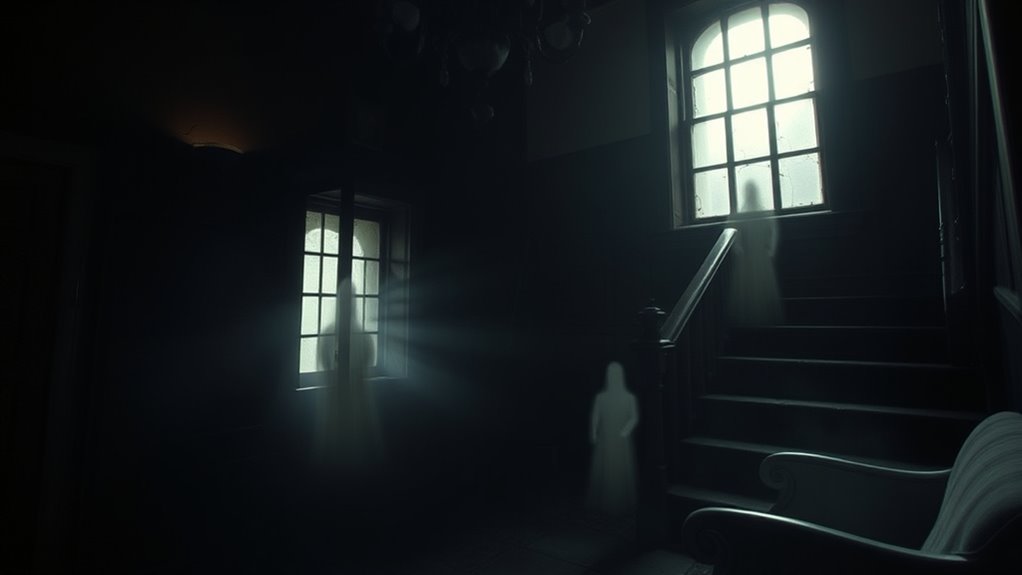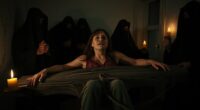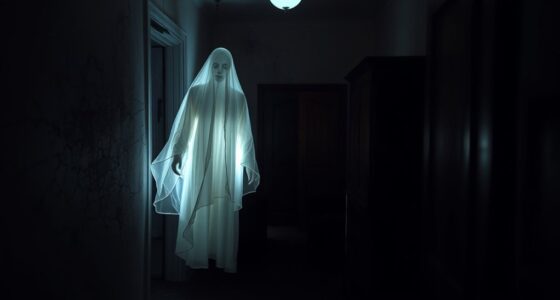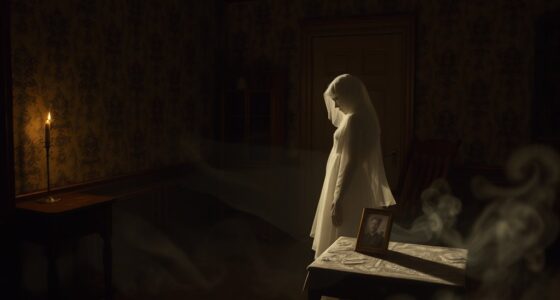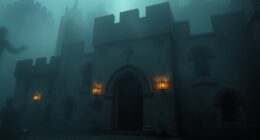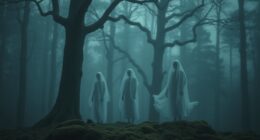In 1716, the Wesley family reported strange phenomena at Epworth Rectory, sparking local folklore and paranormal interest. Witnesses described ghostly apparitions, unexplained noises, and cold drafts, often linked to spiritual unrest tied to the house’s history. Over the years, theories range from supernatural spirits to psychological effects. With ongoing investigations and media coverage, the mystery remains, inviting you to explore more about this intriguing case and its enduring legacy.
Key Takeaways
- The Epworth Rectory ghost story involves unexplained noises, apparitions, and cold drafts targeting the Wesley family in 1716.
- Early reports describe spectral figures, disembodied footsteps, and mysterious sounds witnessed mainly at night.
- Theories interpret phenomena as spiritual unrest, residual energy, or psychological responses like suggestibility and trauma.
- Media coverage amplified the story’s reach, shaping local folklore and cultural perceptions of supernatural activity.
- Modern investigations employ advanced equipment aiming to find tangible evidence, blending scientific methods with supernatural explanations.
Historical Background of Epworth Rectory and the Wesley Family

The Epworth Rectory, located in Lincolnshire, England, has a rich history tied closely to the influential Wesley family. Its architectural history reflects typical Georgian style, featuring simple yet elegant brickwork and symmetrical design, revealing its 18th-century origins. As you explore the rectory, you’ll notice details that have endured through centuries, linking past and present. Local folklore surrounds the property, with stories passed down about spiritual disturbances and ghostly encounters that date back generations. These tales often intertwine with the rectory’s historical significance, making it more than just a building. The Wesley family’s association, especially John Wesley’s early ministry here, cements its legacy as a site of religious and cultural importance, fueling stories that persist in local tradition. Additionally, the site’s historical background is often cited as a reason for the enduring ghost stories and legends associated with the rectory. Understanding its architectural history can offer insights into why the site has become a focal point for tales of the supernatural, blending physical evidence with local belief.
The Early Reports of Unexplained Phenomena in 1716

In 1716, residents and visitors to the Epworth Rectory began reporting strange and unexplainable occurrences that would soon become part of its ghostly lore. These early accounts marked the start of the spiritual phenomena that fueled local stories and paranormal legends. You might have heard about sounds of footsteps without a source, objects moving mysteriously, or icy drafts in warm rooms. These reports were often dismissed at first, but as stories spread, they gained credibility. The phenomena seemed to target the Wesley family, creating an aura of supernatural mystery surrounding the rectory. Such incidents contributed to the reputation of the house as a place haunted by unseen forces, setting the stage for later, more detailed ghostly encounters.
Eyewitness Accounts From the Wesley Household

You’re about to explore firsthand accounts from the Wesley household, where strange events were frequently reported. Their testimonies offer detailed descriptions of encounters, making them valuable for understanding the phenomena. By examining these accounts, you can assess how credible and consistent their experiences truly are. These detailed reports also highlight the importance of eyewitness testimony in paranormal investigations.
Household Encounters Details
Eyewitness accounts from the Wesley household provide compelling insights into their haunting encounters at the Epworth Rectory. They describe hearing ghostly whispers that seem to echo unexpectedly through the halls, unsettling everyone present. Spectral apparitions sometimes appear suddenly, startling those nearby with their ghostly presence. You might notice objects moving on their own, as if pushed by unseen forces, or doors creaking open without explanation. These encounters often happen late at night, when the house is silent and still. The household members felt a mix of fear and curiosity, unsure whether the spirits intended harm or simply wanted to communicate. Their detailed descriptions paint a vivid picture of a restless ghost haunting the very rooms they called home. Additionally, some reports suggest that the haunting phenomena may be influenced by the house’s historical significance and emotional atmosphere. The supernatural activity described aligns with common ghost encounter reports documented in haunted locations.
Witness Testimonies Credibility
The vivid descriptions from the Wesley household members lend a compelling layer to the ghostly phenomena reported at the Epworth Rectory. Their eyewitness testimonies describe phantom apparitions appearing unexpectedly, reinforcing the consistency of supernatural phenomena occurring over multiple nights. You can trust these accounts because they come directly from those who experienced them firsthand, without embellishment. The detailed nature of their observations—such as seeing shadowy figures or hearing unexplained noises—adds credibility. While skeptics might doubt the supernatural explanation, the coherence and repeated nature of these reports strengthen the case. These testimonies, rooted in personal experience, make the supernatural phenomena more convincing, painting a vivid picture of what the household genuinely encountered. Interestingly, some reports have even described supernatural phenomena, aligning with documented ghost sightings from other historical accounts.
The Nature of the Apparitions and Noises Described
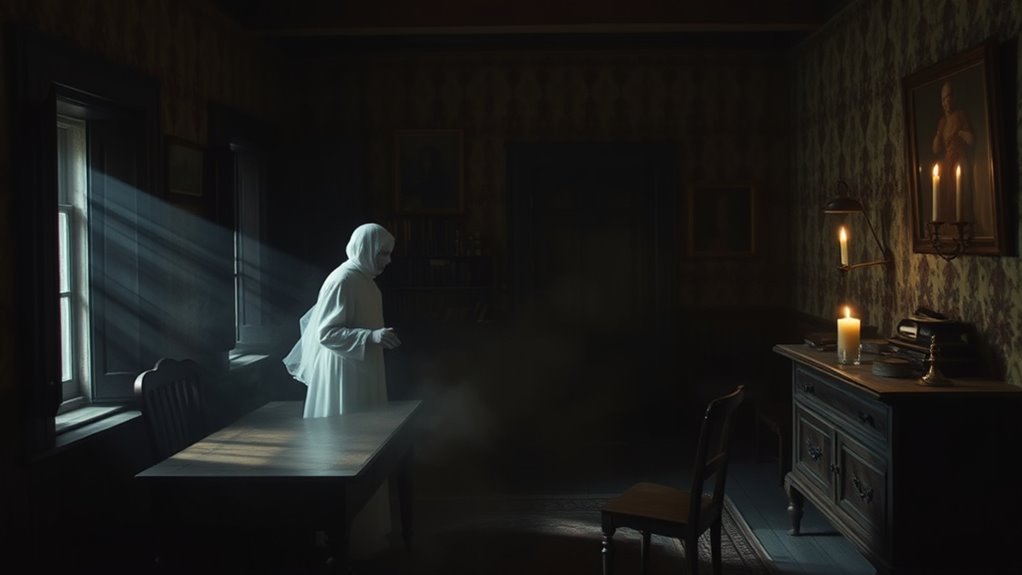
Many of the apparitions and noises reported at the Epworth Rectory exhibit characteristics that are both intriguing and unsettling. These spiritual manifestations often appear as fleeting shadows or unexplained sounds that unsettle those present. You might notice spectral phenomena such as:
Spectral shadows and unexplained sounds create an eerie, lingering presence at the Epworth Rectory.
- Disembodied footsteps echoing in empty hallways
- Apparitions that seem to flicker in and out of visibility
- Unexplained knocking or banging sounds without apparent cause
These phenomena are typically described as fleeting and elusive, making them difficult to document but impossible to ignore. The ghostly figures often seem to be remnants of the past, embodying a sense of lingering presence. Such spectral phenomena can be linked to subconscious fears or unresolved issues from the past, adding another layer of interpretation. Additionally, understanding paranormal activity involves examining how these manifestations might be influenced by environmental or psychological factors. Sometimes, environmental factors such as drafts and noises can contribute to the perception of paranormal activity, and further research into psychological influences can help explain some of these experiences. Although open to interpretation, they remain a compelling aspect of the ghostly lore surrounding the Epworth Rectory.
Theories and Explanations Proposed Over the Years

Over the years, numerous theories and explanations have been proposed to interpret the mysterious phenomena at the Epworth Rectory. Some suggest supernatural explanations, believing the ghost is an actual spirit from the Wesley family’s past. Others lean on psychological theories, proposing that the sightings result from stress, suggestibility, or hallucinations. These ideas aim to rationalize the events without dismissing their emotional impact. The table below summarizes these perspectives:
| Supernatural Explanations | Psychological Theories |
|---|---|
| Spirit of a family member | Hallucinations caused by stress |
| Residual energy from past events | Collective suggestibility |
| Haunting linked to unresolved issues | Sleep paralysis or hypnagogic states |
| Spirit seeking closure | Cognitive biases influencing perception |
Additionally, some researchers consider anomalous energy as a potential factor contributing to these phenomena, although this remains a subject of debate. Exploring body awareness and physical sensations may offer insights into how trauma-related perceptions could influence ghost sightings. Moreover, understanding psychological responses to trauma can shed light on the emotional reactions associated with these experiences. Recognizing the role of stress and suggestibility in perception can help explain the variability in ghost sightings across different individuals. Furthermore, recent studies suggest that perceptual biases may influence how such phenomena are experienced and remembered, adding a layer of complexity to the interpretations.
The Role of Faith and Superstition in the Occurrences
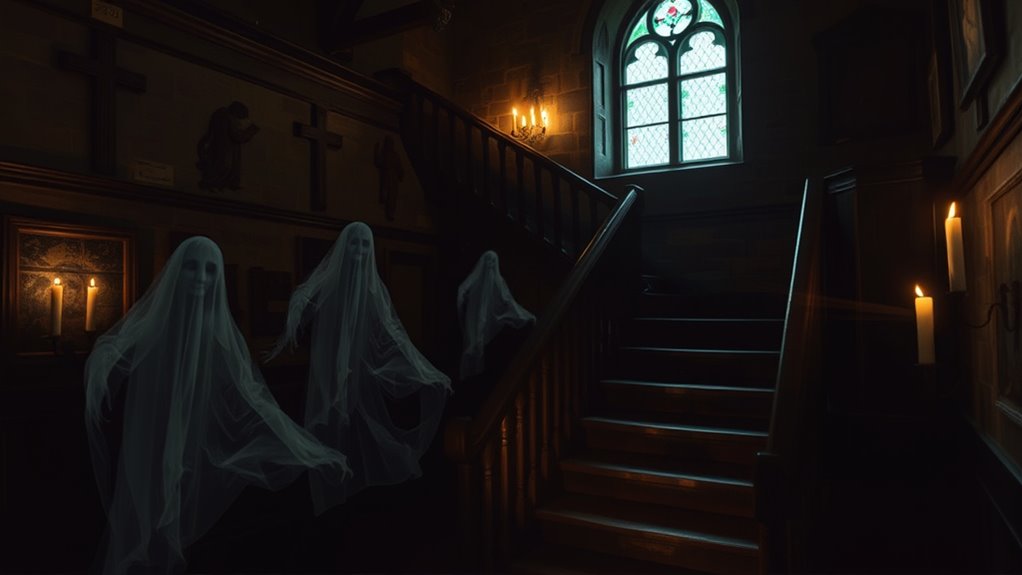
Faith and superstition have played a significant role in shaping how people interpret the mysterious events at the Epworth Rectory. Many believed the ghostly activity was a result of superstitious beliefs, linking it to spiritual unrest or divine punishment. Others preferred faith-based explanations, seeing the phenomena as supernatural signs or messages from beyond. Additionally, some interpretations considered the influence of specialty teas, which were thought to possess mystical properties that could affect perceptions. You might notice that the community’s reactions often involved:
- Rituals or prayers to dispel evil spirits
- Belief that the ghost’s presence was a test of faith
- Interpretations rooted in religious doctrine about spirits or divine intervention
These perspectives reveal how deeply faith and superstition influenced perceptions, turning an unexplained occurrence into a matter of spiritual significance rather than just a physical anomaly.
Media Coverage and Popularity of the Ghost Story

Media coverage has considerably amplified the ghost story’s visibility, shaping public perception and interest. As fascination grows, it influences cultural attitudes toward the supernatural and local history. Understanding these trends reveals how media can elevate a haunting into a lasting cultural phenomenon.
Media Amplification Effects
When reports of the ghost at the Epworth Rectory circulated, media outlets quickly picked up the story, fueling its popularity. Media sensationalism played a key role in amplifying the tale, often exaggerating details to attract more readers. You notice how publicity strategies, like sensational headlines and vivid descriptions, boost the story’s reach. This coverage turns a local legend into a nationwide phenomenon.
Some notable effects include:
- Increased public curiosity, leading to more sightings and reports
- The story becoming a cultural sensation, covered in newspapers and pamphlets
- Heightened interest from paranormal enthusiasts and skeptics alike
Together, these media amplification effects transform a simple ghost story into a widespread phenomenon, demonstrating how media coverage can elevate local legends into iconic tales.
Public Fascination Trends
The ghost story at the Epworth Rectory has captivated public interest, with media coverage fueling an ongoing fascination that shows no signs of waning. As one of the most famous cases of supernatural phenomena, it draws attention from believers and skeptics alike. Popular media outlets have highlighted its eerie details, turning it into a cultural phenomenon. Documentaries, newspaper articles, and online forums keep the story alive, sparking debates and curiosity. Public fascination thrives because of the mystery surrounding the Wesley family’s experiences and the supernatural elements involved. This story’s prominence in popular culture demonstrates how ghost stories like this continue to intrigue audiences, cementing their place in paranormal history and ensuring that the case remains a topic of conversation across generations.
Cultural Impact Significance
As coverage of the Epworth Rectory ghost story has spread across various platforms, its cultural impact has grown considerably, shaping public perceptions of the supernatural. The story’s popularity boosts its role as a symbol of spiritual mysteries, influencing local folklore and national storytelling. It embodies cultural symbolism, representing themes of faith, history, and the unknown. The media’s portrayal amplifies its folklore influence, inspiring books, documentaries, and debates about ghostly encounters. This story’s reach fosters collective memory and identity, reinforcing the supernatural as part of cultural heritage. You see it reflected in:
- Popular media’s dramatization of the ghost’s presence
- Community traditions and local lore
- The enduring fascination with spiritual mysteries
Modern Investigations and Paranormal Studies
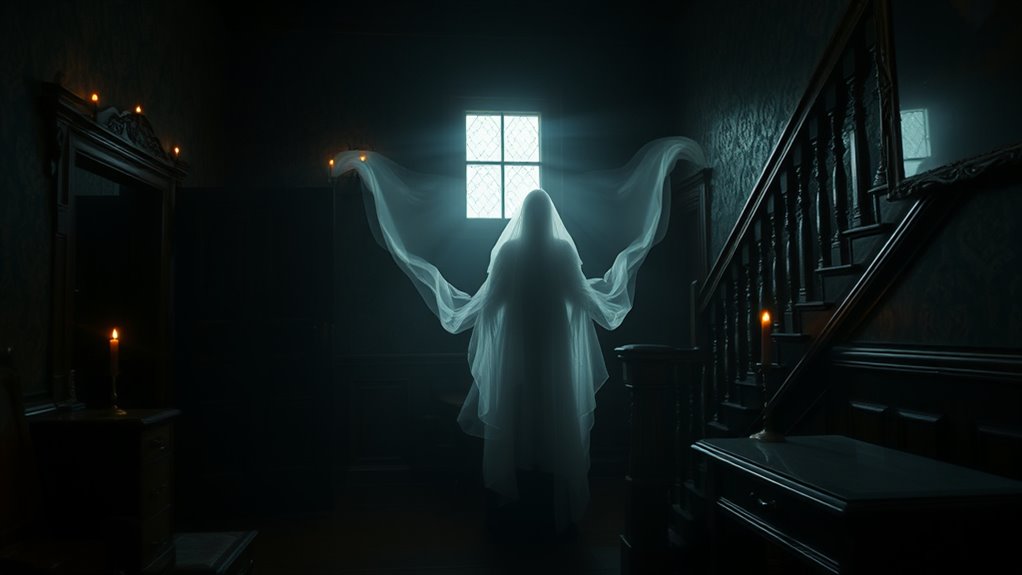
Modern investigations into the Epworth Rectory Ghost have employed a variety of advanced tools and techniques to uncover the truth behind the haunting. Researchers now explore phenomena through the lens of quantum entanglement, seeking connections between the spirit and physical reality. Technological advancements, such as infrared cameras, EVP recorders, and motion sensors, allow for more precise data collection. These tools help capture unexplained sounds or movements, providing tangible evidence of paranormal activity. Additionally, digital analysis techniques analyze data for patterns or anomalies linked to the ghostly encounters. While some skeptics question these methods, they represent a significant step forward in understanding the haunting. Ultimately, these modern investigations aim to bridge science and the supernatural, offering new insights into the long-standing mystery of the Epworth Rectory Ghost.
The Legacy and Continuing Mystery Surrounding the Haunting

Despite decades of investigation and countless theories, the haunting of the Epworth Rectory continues to captivate and mystify both skeptics and believers alike. The legacy persists through stories rooted in ghost folklore, fueling ongoing curiosity. Many see the ghost as a symbol of spiritual symbolism, representing unresolved ties to the past. This enduring mystery keeps the story alive, inspiring new generations to explore its significance. You’ll find that:
- The ghost’s presence is intertwined with spiritual symbolism, suggesting deeper meanings.
- Local folklore preserves the haunting’s reputation, blending fact and legend.
- The ongoing intrigue invites interpretations that challenge skeptics and believers alike.
Ultimately, the haunting’s legacy endures as a mysterious chapter in ghost folklore, leaving questions unanswered and spirits unresolved.
Frequently Asked Questions
Were There Any Physical Injuries Reported During the Hauntings?
You might wonder if there were any physical injuries reported during the hauntings. In many cases, people experience emotional trauma from the unsettling events, but physical injuries are rarely documented. If you’re investigating a similar phenomenon, it’s important to distinguish between emotional trauma and actual physical harm. While some reports suggest minor injuries, most witnesses emphasize the psychological impact rather than physical harm from the paranormal activity.
How Did the Ghostly Activity Affect the Wesley Family’S Daily Life?
Imagine a storm disrupting your peaceful sailing; the Wesley family’s daily routines felt similarly shaken by ghostly activity. You’d find your family routines altered, with disruptions and fears shadowing your days. The emotional impact would weigh heavily, creating an ongoing tension that challenged your sense of safety and normalcy. This haunting cast a long shadow, making ordinary life feel unpredictable and unsettling, demanding resilience amid the unseen storm.
Are There Any Documented Attempts to Communicate With the Spirit?
You might wonder if anyone has tried spirit communication or paranormal investigations with the ghost. While there’s no solid evidence of formal attempts, some stories suggest that family members or investigators attempted to communicate, often using techniques like EVP recordings or séances. These efforts aimed to understand the spirit better, though results remain inconclusive. If you’re interested, exploring paranormal investigations could provide more insight into such ghostly encounters.
What Specific Objects or Areas in the Rectory Were Most Affected?
Imagine you’re investigating a haunted house, and you notice that certain furniture seems possessed—haunted furniture that shifts or moves unexpectedly. You’d find spectral footprints on the floor, especially near the most affected areas. In the Epworth Rectory, these spots included the staircase, the parlor, and key furniture pieces, all showing signs of supernatural activity. These objects and areas bear the brunt of the ghostly disturbances, making them focal points for your exploration.
Has Modern Technology Detected Any Residual Paranormal Energy?
You might wonder if modern technology has picked up residual energy or paranormal imaging. Some investigators report detecting faint traces of residual energy using thermal cameras or EMF detectors, which suggest lingering paranormal presence. However, these findings are often inconclusive. While technology can hint at residual energy, it doesn’t definitively prove ongoing paranormal activity. So, your curiosity about unseen energies remains intriguing, but definitive proof still eludes us.
Conclusion
You can imagine yourself in the Wesley household, feeling both fear and curiosity as unexplained noises echo through the halls. Like the Epworth Rectory ghost, many hauntings leave us questioning what’s real. Whether it’s a genuine spirit or a trick of the mind, these stories remind us that some mysteries persist beyond explanation, inviting us to explore the unknown with an open mind. The legacy of this haunting endures, sparking wonder and debate for generations to come.
